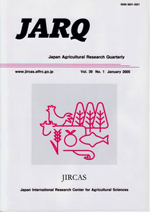Decline in Fertility of Paddy Soils Induced by Paddy Rice and Upland Soybean Rotation, and Measures against the Decline
| ISSN | 00213551 |
|---|---|
| NII recode ID (NCID) | AA0068709X |

Crop rotation between irrigated paddy rice (Oryza sativa L.) and upland soybean [Glycine max (L.) Merr.] (paddy-upland rotation) induces a decline in soil nitrogen (N) fertility, as observed by available soil N. There was a significant negative correlation between the available soil N and the proportion of upland seasons to total crop seasons after the initiation of paddy-upland rotation (upland frequency).The decline in soil N fertility was alleviated by the application of organic materials. Soil total carbon also tended to decrease with an increase in upland frequency. Soil physical properties were affected by the paddy-upland rotation. As soil organic matter decomposed in paddy-upland rotation, the soil density increased with decreasing soil porosity. A suitable range of available soil N for paddy-upland rotation was identified between 80 and 200 mg/kg, the same as for paddy rice. The keys to controlling soil N fertility in paddy-upland rotations are the upland frequency and application of organic materials. To sustain the available soil N over the minimum suitable level of 80 mg/kg, the upland frequency should not exceed approximately 60% when only crop residues and no other organic materials are applied. The upland frequency can be increased by the repeated application of organic materials, thereby maintaining a higher level of available soil N.
| Date of issued | |
|---|---|
| Creator | Mizuhiko NISHIDA |
| Subject |
available soil nitrogen organic materials paddy-upland rotation physical properties of soil upland frequency |
| Available Online | |
| NII resource type vocabulary | Journal Article |
| Volume | 50 |
| Issue | 2 |
| spage | 87 |
| epage | 94 |
| DOI | 10.6090/jarq.50.87 |
| Rights | Japan International Research Center for Agricultural Sciences |
| Relation | : J-STAGE |
| ISBN | Journal Article |
| Language | eng |
